
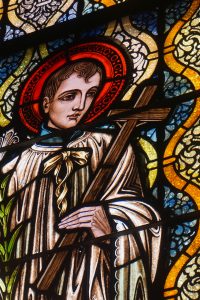 The religious history of the Maronite Catholic community of Utica and the Central New York region began with the first arrivals of immigrants to the Mohawk Valley from their ancestral home in Mt. Lebanon more than a century ago. Records in Historic St. John’s Catholic Church in Utica indicate that there were Maronites in the Utica area as early as 1885. Mention is made of Maronite priests visiting from Mt. Lebanon and conducting liturgy for the Maronite community in Utica and the surrounding area.
The religious history of the Maronite Catholic community of Utica and the Central New York region began with the first arrivals of immigrants to the Mohawk Valley from their ancestral home in Mt. Lebanon more than a century ago. Records in Historic St. John’s Catholic Church in Utica indicate that there were Maronites in the Utica area as early as 1885. Mention is made of Maronite priests visiting from Mt. Lebanon and conducting liturgy for the Maronite community in Utica and the surrounding area.
The Utica Saturday Globe (April 7, 1900) carried an article about the Rev. Michael Khouri, a priest from Zahle in Mt. Lebanon, who was the guest of the Rt. Rev. Msgr. J.S.M. Lynch, pastor of St. John’s Church. Father Khouri celebrated the Divine Liturgy for the Maronites at St. John’s Church. The article also reported that Lebanese in Utica numbered approximately 100, as confirmed by Father Khouri who had taken a census at the time of his visit.
Father Louis Lotaif came to Utica in 1907 and obtained permission from the Bishop of the Diocese of Syracuse to celebrate the Maronite Divine Liturgy in the basement grotto of St. John’s Church. Father Lotaif resided at that time at 764 Bleecker Street in the midst of the Maronite community of East Utica. Even before the first church was erected in 1910, he ministered to the Maronite families, especially those in need.
The Utica Daily Press (May 10, 1910) reported on plans to construct a Maronite Church in Utica at the southeast corner of Albany and Elizabeth Streets. Highlights of this news article included the following:
"The church business was transacted at Anthony Deep’s Oriental Restaurant, 609 Bleecker Street, and the papers were signed by the Rev. Louis Lotaif on behalf of the church, and by Salvatore Rizzo, the Contractor who will do the work. There are about 600 Lebanese immigrants from Mt. Lebanon living in Utica and its vicinity. There is going on quite an emigration of these people from their ancient Oriental land to Utica. Joseph Ferris, steamship agent, who is one of their number, says that about 100 will come here this year. About 20 members of the Lebanese colony are engaged in businesses in the city. There are a number who work in the mills and others make their living peddling. They are an enterprising people and remarkably temperate. Among the prominent representatives of the race who were present yesterday when the contract was signed were Father Lotaif, Joseph Tady, Daher Hobaica, Imon George, Louis Sharky, Joseph Ferris and Anthony Deep."
The Utica Daily Press (December 19, 1910) included a story about the dedication of the first Maronite Church in Utica and reported the following:
"The Church of St. Louis of Gonzaga, the first Maronite Church in the state west of Albany, was dedicated yesterday morning with imposing ceremonies. It is for Syrians of Utica and vicinity….The church is located at the corner of Albany and Elizabeth Streets. The windows are of colored glass and two of them are memorials bearing the names of Elias J. Nassar and Nassar J. Flihan. At the dedication services yesterday the Rev. Louis Lotaif was master of ceremonies and Anthony Deep was head usher. The lay trustees of the church are Daher Hobaica and Joseph Zogby. In his address to the parishioners at the dedication, the Monsignor J.S.M. Lynch, who was the celebrant of the Mass at the dedication, referred to the liturgy at St. John’s Church as follows: We had Syrian [sic] services in St. John’s Church more than 25 years ago. I remember the first time a Maronite priest came to St. John’s to say Mass. In the last quarter of a century I have seen many Maronite priests, and they have all come to St. John’s to say Mass for their people. Monsignor Lynch commented that he deeply regretted that he did “not understand the old Syriac language, which is the language of our Lord Himself.” He also noted that the new St. Louis Church would be “the first Maronite Church between the Hudson River and the Great Lakes, and as the headquarters for all Maronites between Albany and Buffalo.” Also noteworthy in his address was Monsignor Lynch’s high praise for the Maronites as a people: The Maronites are a great people…You ought to be proud that for all these 1500 years the Maronites have kept the faith. They have been persecuted and have been made the victims of some terrible massacres, but for 1500 years they have clung to the faith and they have clung to Rome. In conclusion the Monsignor stressed the loyalty and sacrificial efforts of local Maronites for their church: The most reason you have to be proud is that you have kept the faith. Here in Utica you can be proud of what you have done….You are a noble people and have made sacrifices for your church."
The new parish community proceeded to grow rapidly, soon becoming the center of religious and social life for the Maronite community of the Utica area. Gradually it spread its spiritual 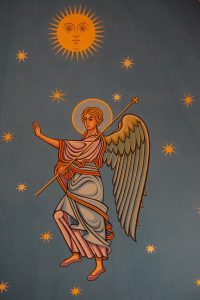 wings and encompassed all the Maronite families residing in the Central New York area and the entire Mohawk Valley. Its growth is evident if we note the increase in the numbers from the 100 Maronites affirmed by Father Khouri in 1900 to the more than 500 who established the first church in 1910 to the approximately 3500 estimated in the 1990 census. Father Lotaif faithfully and generously served St. Louis Church faithfully and selflessly from 1907 until his sudden passing in May of 1929. The young church flourished, prospered and took root in the life of the local community.
wings and encompassed all the Maronite families residing in the Central New York area and the entire Mohawk Valley. Its growth is evident if we note the increase in the numbers from the 100 Maronites affirmed by Father Khouri in 1900 to the more than 500 who established the first church in 1910 to the approximately 3500 estimated in the 1990 census. Father Lotaif faithfully and generously served St. Louis Church faithfully and selflessly from 1907 until his sudden passing in May of 1929. The young church flourished, prospered and took root in the life of the local community.
Father Lotaif’s successor was Father Ignatius Sayegh, who served from June, 1929 to January, 1930. Father Peter Ashkar followed him and held office from February, 1930 to August, 1931, and later Father Peter Sfeir served from December, 1931 to April, 1933. Father Francis Lahoud, who came to St. Louis Gonzaga Church as acting pastor, succeeded Father Sfeir in April, 1933. Eighteen months later, the Bishop of Syracuse, the Most Reverend John A. Duffy, appointed Father Lahoud as the pastor. This appointment signaled a turning point in the fortunes of the parish and opened a new era in the history of the church. The new pastor plunged into his duties with an energy, initiative and zeal. His efforts resulted in great progress and achievements for the parish. At the invitation of Father Lahoud, Bishop Duffy came to Utica in November, 1934 to confirm a class of 80 children from St. Louis parish. The overflowing congregation, now grown to about 400 families and more than 700 adult contributing members (according to church financial records of the 1930’s) packed into the small church and spilled out to the sidewalks and lawn. The crowd dramatically impressed all those present at the confirmation ceremony—from the bishop to the youngest parishioner—that the church edifice was woefully too small for the growing congregation. Prayers and perseverance crowned the efforts of the pastor and parishioners with signal success.
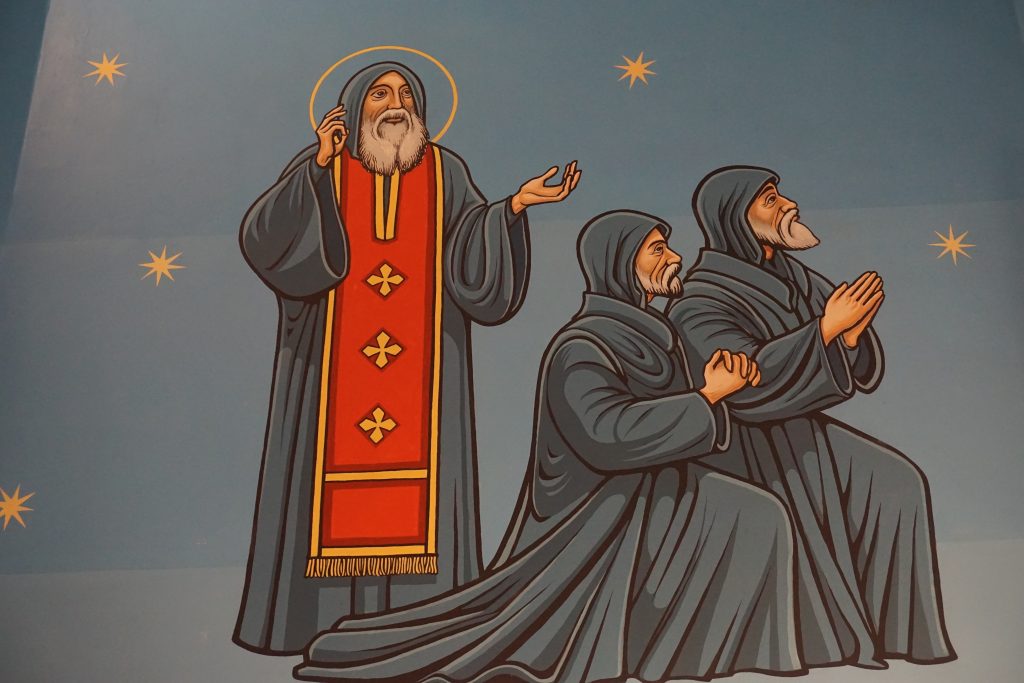 On August 9, 1935 they purchased a lot at the corner of Conkling Avenue and Rutger Street from the First Citizens Bank and Trust Company of Utica. Shortly thereafter they secured a loan of $30,000 from the Oneida National Bank of Utica and the parish was ready to embark on the construction of the new church. Ground-breaking ceremonies took place on October 13, 1935 and on December 1 of the same year, Bishop Duffy laid the cornerstone of the new edifice. Trustees during the construction of the church were David Saber and Deeb George Gastin. Salvador Bianchi was the mason for the project and Mitri Zogby, a parishioner, was the carpenter. Father Lahoud himself was the construction manager. Progress on the construction of the new church was so rapid that on November 23, 1936 the Rt. Rev. Msgr. Daniel Doody, Vicar General of the Diocese, assisted by Father Lahoud, consecrated the main altar. On November 29, 1936 the dedication of the new church took place, highlighted by a Pontifical High Mass, a banquet at Hotel Martin, and a dramatic production, Whatsoever Ye Sow, staged by parishioners in the basement auditorium of the new church. In his sermon during the Pontifical High Mass, Bishop Duffy urged the Maronite faithful of Utica to cling closely to the faith of their fathers that had sustained their people through centuries despite persecution at the hands of Romans, Byzantines, Saracens, Mamelukes and Turks. He cautioned them to not fall away from their ancestral faith, now that they are in America and flourishing in the warm sun of tolerance and prosperity.
On August 9, 1935 they purchased a lot at the corner of Conkling Avenue and Rutger Street from the First Citizens Bank and Trust Company of Utica. Shortly thereafter they secured a loan of $30,000 from the Oneida National Bank of Utica and the parish was ready to embark on the construction of the new church. Ground-breaking ceremonies took place on October 13, 1935 and on December 1 of the same year, Bishop Duffy laid the cornerstone of the new edifice. Trustees during the construction of the church were David Saber and Deeb George Gastin. Salvador Bianchi was the mason for the project and Mitri Zogby, a parishioner, was the carpenter. Father Lahoud himself was the construction manager. Progress on the construction of the new church was so rapid that on November 23, 1936 the Rt. Rev. Msgr. Daniel Doody, Vicar General of the Diocese, assisted by Father Lahoud, consecrated the main altar. On November 29, 1936 the dedication of the new church took place, highlighted by a Pontifical High Mass, a banquet at Hotel Martin, and a dramatic production, Whatsoever Ye Sow, staged by parishioners in the basement auditorium of the new church. In his sermon during the Pontifical High Mass, Bishop Duffy urged the Maronite faithful of Utica to cling closely to the faith of their fathers that had sustained their people through centuries despite persecution at the hands of Romans, Byzantines, Saracens, Mamelukes and Turks. He cautioned them to not fall away from their ancestral faith, now that they are in America and flourishing in the warm sun of tolerance and prosperity.
The dedication of the new church gave impetus and enthusiasm for further accomplishments during Father Lahoud’s pastorate. Improvements included two additional marble side altars dedicated to the Blessed Virgin Mary and Saint Joseph, constructed by Father Lahoud’s own hands. The sanctuary was enhanced by the installation of a communion rail. During World War II the church was completely painted as a result of a vow by the pastor and parishioners to secure divine protection for all those in military service. Finally, in 1951 Father Lahoud, with the strong support of his parishioners, constructed a rectory adjacent to the church. Perhaps the crowning achievement of Father Lahoud’s pastorate was the energetic and highly successful campaign he and his zealous parishioners waged to pay off the mortgage. Within a fortnight, with the wholehearted help of the dedicated Mortgage Fund Committee, the money and pledges began to pour into the church coffers and the quota of $33,400 was soon oversubscribed in munificent fashion--an achievement that stands out as a milestone in the history of St. Louis of Gonzaga Church. Sunday, May 11, 1947 was a memorable day in the annals of St. Louis Gonzaga Church. On that day, the pastor and parishioners burned the mortgage in the presence of His Eminence Eugene Cardinal Tisserant, Secretary of the Sacred Congregation for the Eastern Church. In May 1950—just three years after his first visit to Utica—Cardinal Tisserant paid a second memorable visit to St. Louis Church. Father Lahoud, who was elevated to the rank of Monsignor in 1954, served St. Louis parish from April, 1933 until February 11, 1960 when he passed away unexpectedly after a short illness. After his death, Bishop Walter A. Foery appointed Father Francis Willenburg Administrator of St. Louis Church.
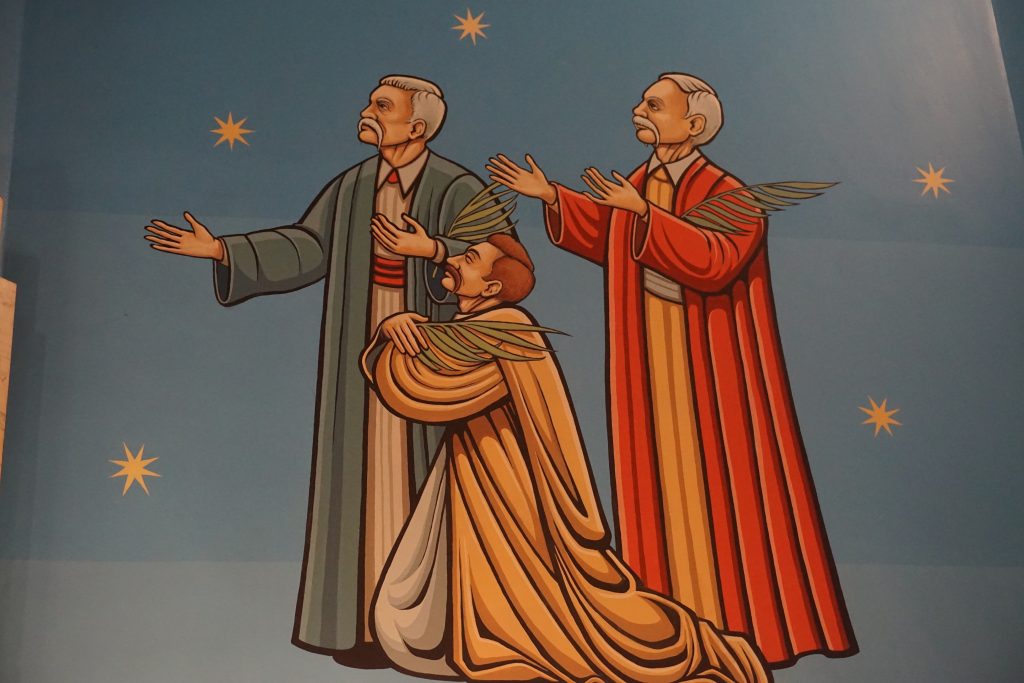 On December 28, 1960 the Maronite Patriarch assigned Monsignor Anthony Korkemaz as pastor of St. Louis Church, transferring him from St. Anthony’s Church in Richmond, Virginia. Monsignor Korkemaz served St. Louis parish until 1964 when the Maronite exarch, Bishop Francis M. Zayek appointed him Chancellor of the newly-created Apostolic Exarchate for the Maronites in Detroit.
On December 28, 1960 the Maronite Patriarch assigned Monsignor Anthony Korkemaz as pastor of St. Louis Church, transferring him from St. Anthony’s Church in Richmond, Virginia. Monsignor Korkemaz served St. Louis parish until 1964 when the Maronite exarch, Bishop Francis M. Zayek appointed him Chancellor of the newly-created Apostolic Exarchate for the Maronites in Detroit.
Father John Andary came to St. Louis parish in 1964 as assistant pastor. In 1968 Bishop Zayek appointed him as pastor. He served ably until 1986 when he retired. His accomplishments included an addition to the rectory, painting of the interior of the church, construction of a side entrance to the church, reconstruction of the front entrance, paving the parking lot, renovation the kitchen, and installation of a new heating system in the church. Under Father Andary’s pastorate, four generations of parishioners of Saint Louis Church numbering more than 4,000 celebrated twin jubilees in 1985: the seventy-fifth anniversary of the establishment of the parish (1910) and the fiftieth anniversary of the construction of the church (1935).
After Father Andary’s retirement in 1986, Father Joseph Thomas came to Utica from Fayetteville, North Carolina and served St. Louis parish as Pastor until December, 1991. Highlighting his activities in Utica were the installation of an elevator in the church and the painting of the mural in the sanctuary. A native son, Paul Salamy, son of Mr. and Mrs. Fred Mazloom, was ordained a subdeacon on October 25, 1989 by Chorbishop Joseph Lahoud and ordained a deacon on September 9, 1995 by Archbishop Francis M. Zayek. Father Peter Karam succeeded Father Thomas as interim pastor and served St. Louis parish until August, 1992, when Father Louis Baz assumed leadership of the parish. Father Baz served the parish from August, 1992 until August, 1993, when Father Bassam Saade was appointed as administrator of the parish.
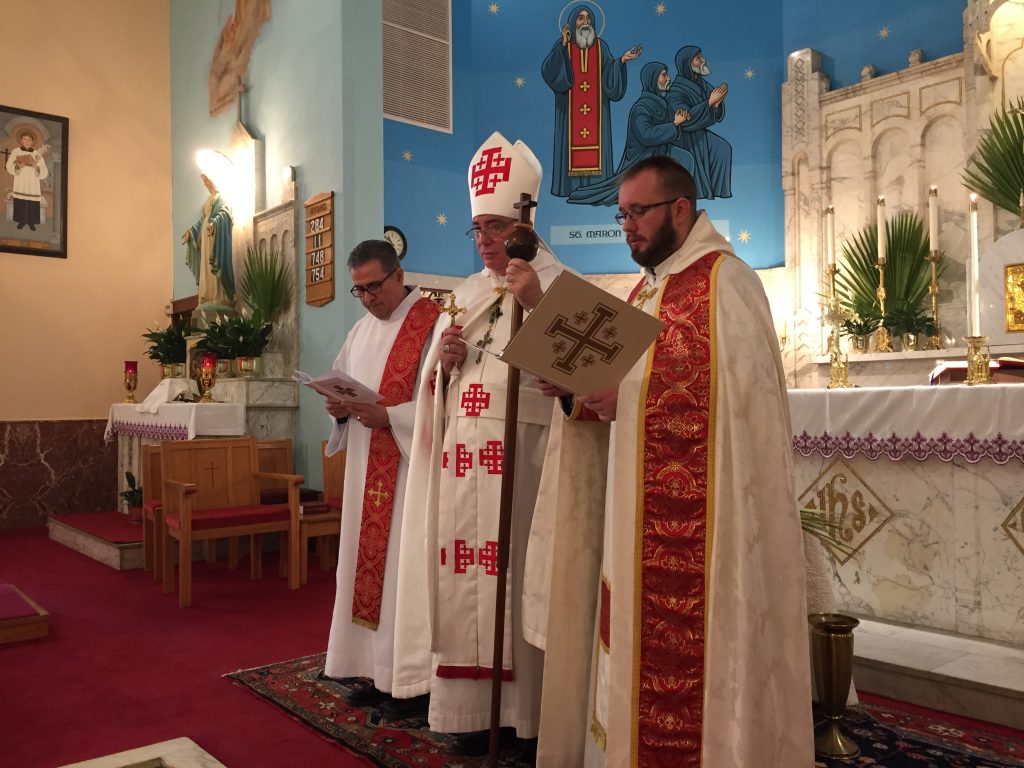
Father Bassam was well equipped by virtue of his education and experience to assume the role of Administrator of St. Louis of Gonzaga Church. His background in business, higher studies in Paris and pastoral experience in Pittsburgh prepared him for a fruitful ministry in the parish. Since his assumption of duties in Utica in 1993, he can be credited with the following major accomplishments: He was eminently successful in organizing the program of activities and in shepherding the parish as host for the National Apostolate of Maronites’ 1994 Regional Convention. A vigorous campaign of updating the church census is which will continue into the future its important role of enrolling and re-enrolling Maronite families into the membership of the church. During his tenure as pastor, Father Saade reinvigorated the Altar Boy’s Society and celebrated the 50th anniversary of Saint Mary’s Guild. Improvements to the physical structure of the church during Father Saade’s pastorate include: repairs to the front entrance and stairs of the church, the installation of outdoor lights and security system, repairs to the basement and refurbishing of the rectory, remodeling of the hall kitchen and the construction of a shrine dedicated to the Blessed Mother, painting of the church and the installation of new carpets.
On June 1, 2009, Bishop Gregory J. Mansour appointed Chorbishop John D. Faris, J.C.O.D. as the pastor. Chorbishop Faris had formerly served for sixteen years in the Eparchy of Saint
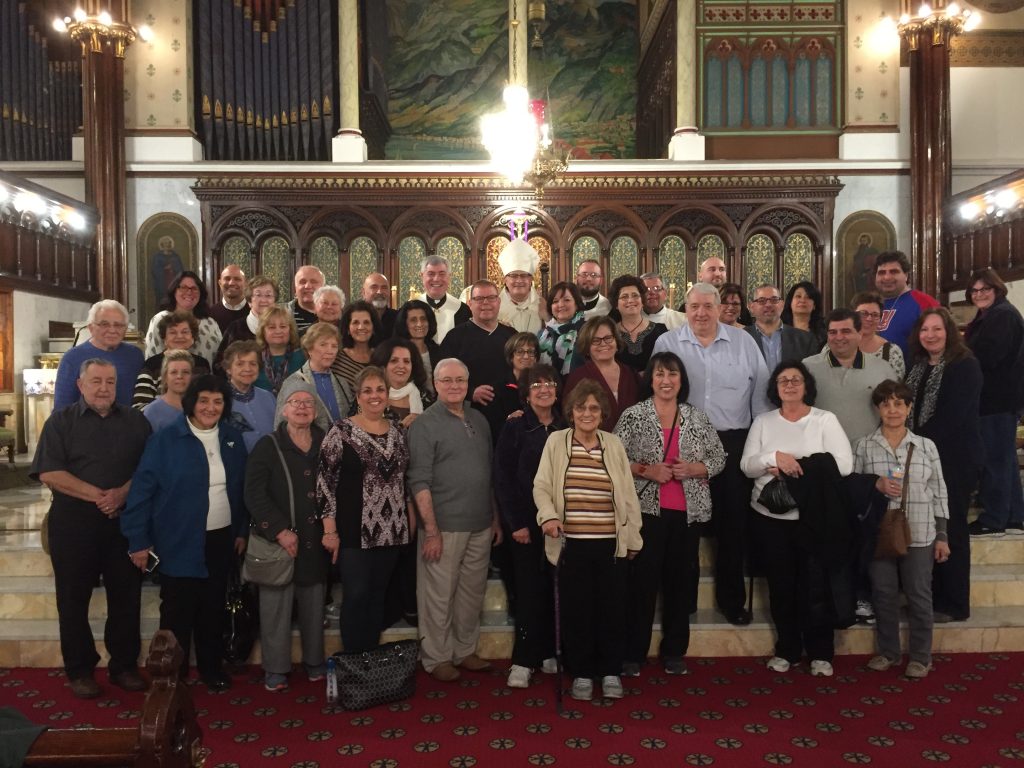
Maron as Chancellor and Vicar General and for thirteen years as the Deputy Secretary General of the Catholic Near East Welfare Association and as Vice President for the Pontifical Mission to Palestine. As a canon lawyer, Chorbishop Faris was the only Eastern Catholic to serve as the President of the Canon Law Society of America. He also continues to write and lecture at The Catholic University of America. As he undertook his responsibilities as pastor, Chorbishop Faris noted that he and the parishioners were “standing on the shoulders of giants” as they begin the second century of faith and family in the life of Saint Louis Gonzaga Church.
